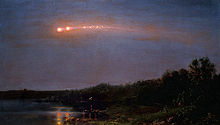掠地火球

掠地火球(Earth-grazing fireball),或称掠地小天体[2]是进入地球的大气层而又再离开的太阳系小天体。如果它在大气层内开始破碎,它可能成为掠地流星串,并且有一些碎片可能会撞击到地球,著名的例子是1972年白日大火球和1860年7月20日的流星列[1][3][4]。
通过大气层的掠地天体,它的质量和速度都会改变,因此当它再回到太空时,它的轨道也会改变[5][6][7]。
通过地球的大气层没有明确的标准,或许在80公里(50英里)以上,或是在卡门线的100公里(62.1英里)。高层的大气没有明确的界限,只是逐渐变得稀薄,从平流层(~50公里)、中气层(~85公里)、热成层(~690公里)、直到散逸层(~1,000公里)(参见热成层顶)。例如,流星体在地球上空85-120公里的高度上成为流星。
掠地小天体或内掠这个名词,有时也用在轨道靠近地球的小行星或流星体(像是距离接近到少于月球距离)。一颗太阳系小天体的掠地轨道不一定要与地球的大气层接触,然而也可能会与地球碰撞(参见近地小行星列表和Outer-grazer)。
已知的掠地火球
掠地火球是很罕见和很少被测量的一种火球[8],是流星体与地球的大气层碰撞,并且在之后还能存在着再离开造成的。迄2008年,有4颗掠地火球被科学性的观察[9]。
- 1860年大流星:被画家弗雷德里克·雀屈(Frederic Church)画下,并被华特·惠特曼在诗中描述,至2010年才被认定是掠地火球[1][3][4]
- 1913年2月9日流星串:可能原自地球捕获的一天然卫星碎裂[10]。
- 1972年白日大火球:US19720810在美国和加拿大上空以每秒15公里的速度掠过(第一颗被科学性观察)。
- 1990年10月13日掠地流星体:一颗质量40公斤,以每秒41.5公里的速度,97.9公里的高度从捷克斯洛伐克上空掠过[7]。
- 2006年3月29日:一颗火球以每秒18.8公里、71.4公里的高度掠过日本上空[11][12]。
- 2007年8月7日:EN070807通过,轨道是罕见的阿登型小行星 [8][13]。
相关条目
参考资料
- ^ 1.0 1.1 1.2 Texas State astronomers solve Walt Whitman meteor mystery. Texas State University. [2011-08-06]. (原始内容存档于2011-10-19).
- ^ APOD: 2009 March 2 - Earthgrazer: The Great Daylight Fireball of 1972. apod.nasa.gov. [2022-11-03]. (原始内容存档于2020-09-14).
- ^ 3.0 3.1 Images of Harper's Weekly front page story. [2011-08-06]. (原始内容存档于2010-06-05).
- ^ 4.0 4.1 Cosmic Log - 150-year-old meteor mystery solved. MSN. 2010-06-02 [2022-11-03]. (原始内容存档于2010-06-05).
- ^ US19720810 (Daylight Earth grazer) 互联网档案馆的存档,存档日期2004-03-07. Global Superbolic Network Archive, 2000, 'Size: 5 to 10 m'
- ^ Daylight Fireball of August 10, 1972. [2022-11-03]. (原始内容存档于2005-01-20).
- ^ 7.0 7.1 Spurny', P.; Ceplecha, Z.; Borovicka, J. Earth-grazing fireball: Czechoslovakia, Poland, October 13, 1990, 03h27m16sUT (页面存档备份,存于互联网档案馆). WGN, Vol. 19, Nr. 1, p. 13; (aphelion of its orbit changed from 2.80 AU to 1.80 AU)
- ^ 8.0 8.1 P. Spurný, J. Borovička, Z. Ceplecha and L. Shrbený, Astronomical Institute of the Academy of Sciences, Fričova 298, CZ-251 65 Ondřejov Observatory, Czech Republic Precise Multi-instrument Data on 45 Fireballs Recorded over Central Europe in the Period 2006-2008 (页面存档备份,存于互联网档案馆). Retrieved 2008-07-06
- ^ Although other grazers have been seen and, rarely, photographed, without specialised scientific observations their orbits cannot be determined. An example is the Leonid grazer over Hawaii in 2001-11-18 -Abe 2006 (PDF)
- ^ O'Keefe, John A. A Probable Natural Satellite: The Meteor Procession of February 9 1913. Journal of the Royal Astronomical Society of Canada. 1959-04-01, 53 [2022-11-03]. ISSN 0035-872X. (原始内容存档于2022-11-03).
- ^ Abe 2006 (abstract)
- ^ Abe 2006 (PDF) approximately 100 kg, orbit aphelion reaches Jupiter
- ^ EN indicates the European Fireball Network
进阶读物
外部链接
- Fireball of 1972 (页面存档备份,存于互联网档案馆)
- Fireball of 1860 (页面存档备份,存于互联网档案馆) (painting)
| |||||||||||||||||||||||||||||||||||||
| |||||||||||||||||||||||||||||||
Text is available under the CC BY-SA 4.0 license; additional terms may apply.
Images, videos and audio are available under their respective licenses.

